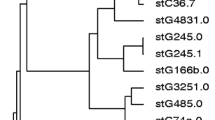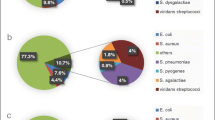Abstract
The purpose of this investigation was to provide a comprehensive review of the pathogenic role and spectrum of disease of milleri group streptococci, with special attention to bloodstream invasion and to possible differential roles among the three species. All consecutive isolates of milleri group streptococci from any anatomic source, during a 37-month period, in a tertiary care teaching hospital in Tel-Aviv, Israel, were thoroughly investigated. Identification to the species level was performed by an automated system.Streptococcus anginosus constituted 82% of the 245 patient-unique isolates from hospitalized patients. All nonurinary isolates were involved in pyogenic infections mostly originating from the gastrointestinal tract, with bacteremia in 28 cases. The 71 urinary isolates represented either urinary tract infection or nonsignificant bacteriuria. No specific association could be detected between species and the infection site, except for a higher relative representation of Streptococcus constellatus in bacteremia. Milleri group streptococci are common in clinical practice and play a different pathogenic role to other viridans streptococci. Due to their invariable association with pyogenic processes, their presence in blood warrants immediate focus identification. In addition, they have a previously unappreciated clinical niche concerning urinary tract infection. The identification of viridans streptococci to the species level is of paramount clinical significance.
Similar content being viewed by others
References
Facklam R (2002) What happened to the streptococci: overview of taxonomic and nomenclature changes. Clin Microbiol Rev 15:613–630
Piscitelli SC, Shwed J, Schreckenberger P, Danziger LH (1992) Streptococcus milleri group: renewed interest in an elusive pathogen. Eur J Clin Microbiol Infect Dis 11:491–498
Gossling J (1988) Occurrence and pathogenicity of the Streptococcus milleri group. Rev Infect Dis 10:257–285
Whiley RA, Beighton D, Winstanley TG, Fraser HY, Hardie JM (1992) Streptococcus intermedius, Streptococcus constellatus, and Streptococcus anginosus (the Streptococcus milleri group): association with different body sites and clinical infections. J Clin Microbiol 30:243–244
Jacobs JA, Pietersen HG, Stobberingh EE, Soeters PB (1994) Bacteremia involving the “Streptococcus milleri” group: analysis of 19 cases. Clin Infect Dis 19:704–713
Casariego E, Rodriguez A, Corredoira JC, Alonso P, Coira A, Bal M, López MJ, Varela J (1996) Prospective study of Streptococcus milleri bacteremia. Eur J Clin Microbiol Infect Dis 15:194–200
Salavert M, Gómez L, Rodriguez-Carballeira M, Xercavins M, Freixas N, Garau J (1996) Seven-year review of bacteremia caused by Streptococcus milleri and other viridans streptococci. Eur J Clin Microbiol Infect Dis 15:365–371
Bert F, Bariou-Lancelin M, Lambert-Zechovsky N (1998) Clinical significance of bacteremia involving the “Streptococcus milleri” group: 51 cases and review. Clin Infect Dis 27:385–387
Weightman NC, Barnham MR, Dove M (2004) Streptococcus milleri group bacteraemia in North Yorkshire, England (1989–2000). Indian J Med Res 119(Suppl):164–167
Stelzmueller I, Pfausler B, Fille M, Dossett LA, Bonatti H (2009) Streptococcus milleri group isolates from blood cultures: consider surgical sepsis. Surg Infect (Larchmt) 10:259–263
Stelzmueller I, Biebl M, Berger N, Eller M, Mendez J, Fille M, Angerer K, Schmid T, Lorenz I, Margreiter R, Bonatti H (2007) Relevance of group milleri streptococci in thoracic surgery: a clinical update. Am Surg 73:492–497
Ripley RT, Cothren CC, Moore EE, Long J, Johnson JL, Haenel JB (2006) Streptococcus milleri infections of the pleural space: operative management predominates. Am J Surg 192:817–821
Kowlessar PI, O’Connell NH, Mitchell RD, Elliott S, Elliott TS (2006) Management of patients with Streptococcus milleri brain abscesses. J Infect 52:443–450
Hardwick RH, Taylor A, Thompson MH, Jones E, Roe AM (2000) Association between Streptococcus milleri and abscess formation after appendicitis. Ann R Coll Surg Engl 82:24–26
Stelzmueller I, Aigner F, Albright J, Margreiter R, Fille M, Swenson BR, Dossett L, Bonatti H (2010) Group Milleri Streptococci in perianal infections. Colorectal Dis 12:e121–e127
Rankhethoa NM, Prescott CA (2008) Significance of Streptococcus milleri in acute rhinosinusitis with complications. J Laryngol Otol 122:810–813
Hirai T, Kimura S, Mori N (2005) Head and neck infections caused by Streptococcus milleri group: an analysis of 17 cases. Auris Nasus Larynx 32:55–58
Belko J, Goldmann DA, Macone A, Zaidi AKM (2002) Clinically significant infections with organisms of the Streptococcus milleri group. Pediatr Infect Dis J 21:715–723
Stelzmueller I, Fille M, Hager J, Dossett L, Sifri CD, Bonatti H (2009) Group Milleri Streptococci in paediatric infections. Eur J Pediatr Surg 19:21–24
Jackson DS, Welch DF, Pickett DA, Mukwaya GM, Kuhls TL (1995) Suppurative infections in children caused by non-beta-hemolytic members of the Streptococcus milleri group. Pediatr Infect Dis J 14:80–82
Stelzmueller I, Berger N, Wiesmayr S, Eller M, Tabarelli W, Fille M, Margreiter R, Bonatti H (2007) Group milleri streptococci: significant pathogens in solid organ recipients. Transpl Int 20:51–56
Parkins MD, Sibley CD, Surette MG, Rabin HR (2008) The Streptococcus milleri group—an unrecognized cause of disease in cystic fibrosis: a case series and literature review. Pediatr Pulmonol 43:490–497
Molina JM, Leport C, Bure A, Wolff M, Michon C, Vilde JL (1991) Clinical and bacterial features of infections caused by Streptococcus milleri. Scand J Infect Dis 23:659–666
Jacobs JA, Pietersen HG, Stobberingh EE, Soeters PB (1995) Streptococcus anginosus, Streptococcus constellatus and Streptococcus intermedius. Clinical relevance, hemolytic and serologic characteristics. Am J Clin Pathol 104:547–553
Claridge JE 3rd, Attorri S, Musher DM, Hebert J, Dunbar S (2001) Streptococcus intermedius, Streptococcus constellatus, and Streptococcus anginosus (“Streptococcus milleri group”) are of different clinical importance and are not equally associated with abscess. Clin Infect Dis 32:1511–1515
Laupland KB, Ross T, Church DL, Gregson DB (2006) Population-based surveillance of invasive pyogenic streptococcal infection in a large Canadian region. Clin Microbiol Infect 12:224–230
Funke G, Funke-Kissling P (2005) Performance of the new VITEK 2 GP card for identification of medically relevant gram-positive cocci in a routine clinical laboratory. J Clin Microbiol 43:84–88
Haanperä M, Jalava J, Huovinen P, Meurman O, Rantakokko-Jalava K (2007) Identification of alpha-hemolytic streptococci by pyrosequencing the 16S rRNA gene and by use of VITEK 2. J Clin Microbiol 45:762–770
Ruoff KL (1988) Streptococcus anginosus (“Streptococcus milleri”): the unrecognized pathogen. Clin Microbiol Rev 1:102–108
Conflict of interest
All authors: none.
Author information
Authors and Affiliations
Corresponding author
Rights and permissions
About this article
Cite this article
Siegman-Igra, Y., Azmon, Y. & Schwartz, D. Milleri group streptococcus—a stepchild in the viridans family. Eur J Clin Microbiol Infect Dis 31, 2453–2459 (2012). https://doi.org/10.1007/s10096-012-1589-7
Received:
Accepted:
Published:
Issue Date:
DOI: https://doi.org/10.1007/s10096-012-1589-7




